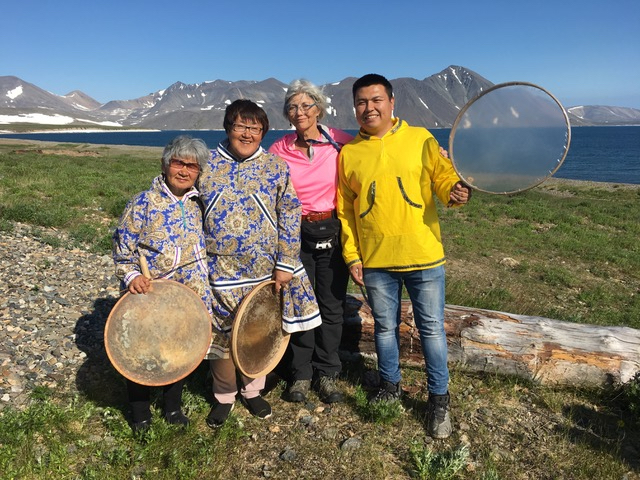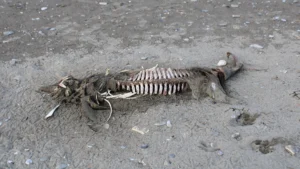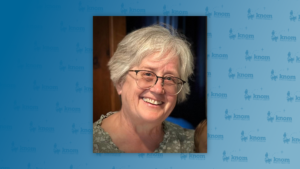In 2017, the Alaska Airmen’s Association and representatives from the Federal Aviation Administration reestablished the civil air route between Provideniya and Nome, which had existed since the first “friendship flight” in 1988.
The fees to travel there were recently reduced, and a group flight was organized for the summer of 2019. After surmounting a number of hurdles, from logistics and paperwork to inclement weather, the trip across the International Date Line finally took place in July.
What does it take to fly from Nome to eastern Russia? And how has the experience of the journey changed — or remained the same — in the 31 years since that historic, first friendship flight? That’s the subject of this installment of KNOM Profiles.
Tandy Wallack of Circumpolar Expeditions explains how travel between Western Alaska and Russia is possible, through friendship flights such as the one that happened earlier this month, on July 7.
“So, the Alaska Airmen’s Association worked with the FAA and the Russian Civil Aviation to establish this route, B369. B369 was the route that was flown for lend-lease back in the early 40’s, when the U.S. transported hundreds of planes over to Russia. So it’s nothing new, as far as that route is established, but they were able to get the agreement for civil aviation, so for small planes to be able to do it. In the early 2000’s, I did a few trips for them to fly over to Provideniya, and we wanted to go on down to Anadyr, but that just didn’t happen, and then for 15 years or so, it was dead in the water. But then, Marshall Severson brought it back up again, and he flew over in 2017, and he’s been the one to work with the FAA to make sure that we keep this route open. And what we want to do next year is fly down to Anadyr, as well, because that route is established.”
Originally, Wallack’s group was scheduled to depart Nome on June 23, but weather between here and the Russian side prevented the group from flying that day.
Wallack: “And part of the thing here is, and I’m not a pilot, but the Russian side has high minimums for small aircraft. If it was on the U.S. side, they could fly in under lower minimums. We are trying to work with them, obviously for safety, but if they lower the minimums for safety and (continue) to be safe, then the weather factor wouldn’t be as much of an obstacle. It’s still going to be an obstacle, but weather is weather. We know that.”
KNOM: “Within all of this, obviously the Cold War, the politics between Russia and the U.S were a big obstacle, and there’s still some of that, but what would you say is the biggest challenge to maintaining travel and these friendship flights between Russia and Alaska?”
Wallack: “Well, it’s the paperwork. That needs to be done prior to going over there, Chukotka particularly, because they are a closed area of Russia.”
KNOM: “So you were down to two pilots and six people. Who were the other members of the group? Were they tourists, were they Alaska residents?”
Wallack: “We had Dan and Vicky. (They) were from Ohio, and they had their private plane. And then John and Sherry from Florida. John Dahlen from the Alaska Airmen’s Association was a copilot on one of the planes, and then myself. So we had two Alaskans, and the rest were from the outside.”

At first, there were seven pilots and their accompanying planes ready to make the trip on June 23, but by the time the weather cleared, and the group was able to fly on July 7, there were only two pilots left. John Bone was one of them.
“I would sort of describe myself as an adventure pilot, and I’m a retired Delta Airlines pilot. I’ve had a number of small airplanes over the years, and two years ago, I flew this particular airplane around the world.”
John Bone was the pilot on his own plane, a Cirrus SR22, as he flew across the Bering Strait and back for this particular trip. He describes the preparation, cost, and logistics involved in flying to Chukotka.
“There are several permits that are required, but the one that is difficult is the Chukotka entry permit. That takes 60 days to get, and it’s good for a month. Tandy is trying to get that changed to 72 hours, which is what they do on the eastern side of Russia. You can enter, for example, into St. Petersburg from Sweden or Norway if you’re on a cruise ship or traveling. You can get a permit to enter that part of Russia in 72 hours, and that’s what they need to do here, because it’s 60 days to get a permit that you may or may not be able to use, depending on the weather.
“The cost is not that bad; the most expensive one is a Russian visa. I bought a three-year, multi-entry Russian visa, because I thought I might come back next year, and it’s about $450. The aircraft portion of it, which included the entry permit to enter Russian airspace and land over there, ran about $750, and that included handling at the airport over there. The cost to organize housing and catering ran about $200 a night, which did not include hot water.” (He laughs.)
KNOM: “You describe yourself as an adventure pilot. The fees were reduced to make this happen (for you) logistically, but really, what is the draw for a pilot to fly from Nome across the Bering Strait into Russia?”
Bone: “Well, it’s something that is rarely done, so it’s a bit of a challenge involved, and just getting all of the permits and dealing with some of the procedures with flying into Russia. The fact that very few planes have flown it and it’s so weather dependent that there’s a very narrow window to be able to get over there and spend a few days, then come back. One of the things that I enjoy about adventure flying is meeting different people and seeing different cultures, and flying over to Provideniya is very rewarding in that regard because it is quite different. The route that we fly goes up along the coast of Alaska and then crosses right over the top of the Diomede Islands to the farthest eastern point in Siberia there. The over-water distance between the two is only 62 miles. And then, we go down the east coast from Siberia to Provideniya, which is only 275 miles, and we take that route to reduce the amount of over-the-water time. If you were to fly directly from Nome over to Provideniya, it’s only 151 miles. But it seems like a million miles away, because it is so different. The streets are not paved, there’s no hot water, no hot water anywhere in town. There’s no restaurants, there’s no hotels, there’s no bars. There’s a small trade school there, and part of it is closed during the summer months, so we were able to stay in the trade school in what would normally be student housing.”
Most of the group’s accommodations were organized by Wallack, who has been traveling to Chukotka, Provideniya, “New” (Novoye) Chaplino, and elsewhere in Eastern Russia for decades. She says she keeps going back because of the people.
“Every time I go over there, and I meet with my friends and go to places like New Chaplino, the warmth, the hospitality that they show, and the hunger for keeping in contact with folks in Alaska — that’s what keeps me going. I have this passion and I get strength from the native people over there as well as the native people over here. I love that, being able to accomplish that connection. And every time we do this, it gets a little bit easier and easier, and they get used to small planes coming over there and the process. It’s that people-to-people contact that we must keep alive between the two.”
When asked about the future of friendship flights between Nome and the Chukokta Peninsula (or Chukchi Peninsula as it is more commonly known), Wallack did not hesitate to say she’s confident the effort will continue. She also says the interest in this air route from pilots around the country is growing.
Here is John Bone’s response to the same question.
“Well, there is a future for it. And one of the things I would like to do (in the future)… the schools are very nice, and the children over there were very polite and well mannered, and every single one of them was very curious about aviation and airplanes, which is something that they don’t see over there. They get a commercial flight from Anadyr maybe once a week, but they don’t see planes over there, and the children were very interested in it. And they teach English in the schools there to the children. I’d like to go back over there and let the children come out and see the planes and take them flying.”
Nome’s Mayor Richard Beneville has been involved with the friendship flights between Providenya and Nome since the late 80’s. He continues to support travel between the two sister cities today as mayor.
“Wonderful idea, the whole thing was reaching across the Bering Straits, the logo was two hands shaking with the Bering Straits behind. My nephew had a big part in decorating and all that. But that’s where the heart (was). And I can tell you because of things I have heard from Russia, via diplomats and people within circles, I find myself swinging in a bit, it was very well thought of in Russia. Not so much the sister city thing, but the contact and the development of contact. And we, for reasons, 9/11 included, haven’t really pursued it. Back to sister cities, so we became a sister city with Provideniya (in the late 80s), and nothing really came of it. Jump shift, and now I’m Mayor of Nome, and it’s one of the thoughts in my head.
“A mutual friend, a good friend of mine, I’ve known her for 30 years, and we have so much in common, Tandy Wallack. She and I talked about it…I’ll never forget her coming back from a trip to Provideniya maybe four or five years ago, and she said she mentioned to the mayor of Provideniya that Provideniya and Nome are sister cities, and the guy gave her a really blank look. He really didn’t know anything about it, the history of it, what it was, nothing, absolutely nothing. So I think she got in her head that we should do this, and I think it’s a great idea, but I’m not exactly sure what the next step is, and that’s how it is with these things, because they are kind of amorphous, and I think that I probably, to a degree, have dropped the ball, in that I didn’t write a letter. Dear Mayor…your name is, sir… privyet. I haven’t done it, and it’s probably one of those things that I should do.
“Do I think on the philosophical end, that it’s a good idea? Absolutely. Absolutely. Now, perhaps more than ever, because of climate change, the proximity we have to Russia, and the ties that inexorably we have and will have because of that.”
Wallack plans to send a letter of support for the friendship flights to the Russian ambassador to the U.S., Anatoly Antonov, which Mayor Beneville plans to sign. The hope is that the ambassador will help Wallack and various groups in the future who use the civil air route procure a 72-hour travel visa for their trips. This would eliminate the need to apply for a different visa that includes a 60-day waiting period.
Wallack says she is also planning a trip with residents of St. Lawrence Island in the near future, so that they can visit their relatives in Chukotka. This next venture could involve an original umiak and travel by boat rather than an airplane.
Image at top: The New Chapilino Dance Group. Photo: Tandy Wallack, used with permission.







